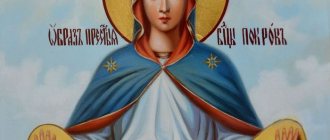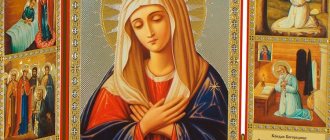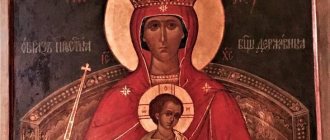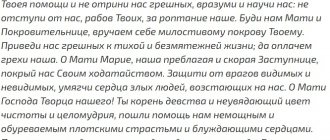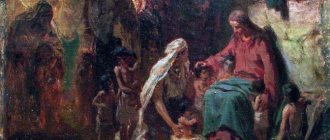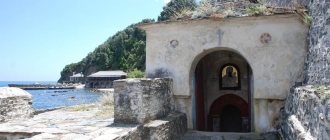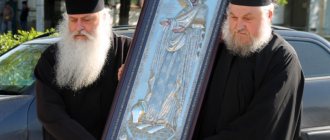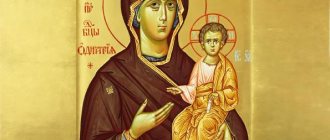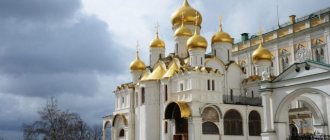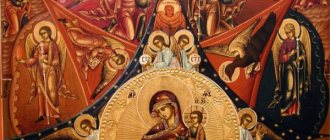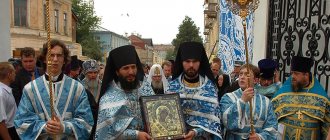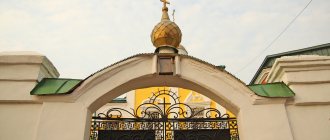Athos and one of the icons, namely the “Quick to Hear” icon, can be considered the ancestral home of a large number of miraculous images. The glory of this miraculous face was brought by his grace-filled power, which cured many people from various ailments and ailments.
Date of celebration: November 22
It is believed that the “Quick to Hear” is just a copy from the icon of the Mother of God located in Alexandria. The image was painted around the tenth century. This holy face revealed the first miracle in the mid-17th century.
Origin story
The painting of the icon dates back to the 10th century, and permission for its creation was given by the head of the Dohiar monastery, which was located on Mount Athos. For a long time, the icon did not have a specific name, and only in the 17th century, after the first miracle associated with the icon, it was dubbed the “Quick to Hear.”
According to historical chronicles, until 1664 the icon stood at the entrance to the refectory of the monastery and did not show its power in any way. One night, the then celebrant walked past the door, and soot from a candle fell on the face of the icon, significantly staining it. At that same hour, a voice rang out in the monk’s head, forbidding him to carry the cinder so close to the icon of the Mother of God, so as not to cause even more damage to it. He did not believe in the truth of the voice, thinking that his brothers in faith were playing him.
After some time, the monk once again passed by the icon, and the flame of the candle again scorched its face. A voice was heard from heaven, which called the monk unworthy to bear his rank, after which the man became blind. The true essence of the origin of the voice reached the monk, and he accepted his punishment as due. After this, he atone for his sin for a long time in front of the icon, asking for its forgiveness. The prayers were heard, and along with the restoration of his sight, the monk was told the new name of the icon - “Quick to Hear.”
Glorification of the miraculous image
And it was like this. On Mount Athos there is the Dohiar monastery and, as history testifies, in 1664 a monk whose name was Nil served there. Every evening, while performing his official duties, he went to the refectory, using a lit torch as a light for the road. The place of the icon of the Mother of God “Quick to Hear” was right above the entrance and every day, for a long time, soot from a splinter fell onto the shrine.
And then one day the monk was walking past the holy image, and suddenly a voice from above began to insistently demand that they stop smoking the holy image. However, what was said was ignored by the minister of the church with the thought that it was their own brothers who decided to play a joke or were being tempted by an evil spirit. So the “Quick to Hear” icon continued to be smoked every day, but no one paid any attention to this. The Mother of God was angry with the monk for being so careless and inattentive.
When the careless church minister was again heading to the refectory, the voice coming from heaven again began the conversation that had already become familiar. And then suddenly darkness fell before Neil, he lost his sight and became blind. The monk realized that the source of the voice was the icon of the Most Holy Theotokos “Quick to Hear,” and fear seized his soul.
Neil fell down before the face, begging for merciful forgiveness. He lay there all night, and early in the morning his brothers gathered and Neil told about what had happened. The monks became frightened by what was told, each of them also fell to the image, and with the onset of evening an unquenchable lamp was hung in front of the image.
The monk did not leave the icon of the Mother of God the Novitiate for days on end, offering prayers and requests for forgiveness. And he spent the night there, asking the Mother of God to forgive him for treating the holy image with such disrespect and crying out for mercy. Pretty soon the repentance was heard and the icon said: “I hear you praying, Nile. Your eyes can see the light again by the grace of God. And from now on, call this image “Quick to Hear.” From that moment on, this is exactly what people call an icon.
Tradition says that this happened on the ninth day of November in 1664. It was then that the suffering began to come to the image with requests for help and healing. Since then, the miraculous icon “Quick to Hear” has helped them. And he continues to help today, as before. On Mount Athos there is a book where it is written how many believers were miraculously healed.
Meaning in Orthodoxy
The miraculous icon “Quick to Hear,” dedicated to the Most Holy Mother of God and her son Jesus Christ, has several meanings for Orthodox Christians, the essence of which is as follows:
- It is necessary to honor and treat with care all the faces of saints, regardless of their strength.
- Believers should not forget the importance of repentance.
- True prayer coming from the heart will always be rewarded, and the person will receive forgiveness and blessing.
The meaning of the image “Quick to Hear”
The Mother of God is a guiding star for all Orthodox Christians.
According to legend, the image is more than a thousand years old. This is one of the most original boards that has survived to this day. It depicts the Mother of God holding on her left hand the Child, blessing all believers. With her right hand, the Virgin Mary points to Jesus as the Messiah and Savior.
Previously, the board was called differently. “Quick to Hear” is a name that the image acquired only in the 17th century. The name of the icon means quickly hearing, that is, quickly responding to requests and prayers. The Mother of God herself spoke about this when she appeared to one of the monks from the monastery.
This icon should be treated with special reverence, since it is a prototype of the holy face. The legend about the appearance of the icon indicates that the Mother of God deserves special veneration and will not tolerate disrespect or ridicule of herself.
In which temples can you find lists today?
Despite the fact that the original icon never left the walls of the monastery, copies of it were popular among believers and were sent to a large number of churches. Among the monasteries that house specimens that have survived to this day are:
- Spaso-Voznesensk Convent, located in the city of Jerusalem.
- Women's Pechora Mother of God Monastery.
- Holy Cross Cathedral in Petrozavodsk.
- Holy Trinity Church in Belopesetsky.
- Church of St. Martin the Confessor in Arkhangelsk.
- Cathedral of St. Simeon in Chelyabinsk.
- Church of the Nativity of the Virgin Mary in the village of Doropeevich.
- Holy Trinity Cathedral of the Alexander Nevsky Lavra in St. Petersburg.
Spaso-Voznesensk Convent in Jerusalem
An Orthodox convent built on the Mount of Olives in 1905. Initially, the monastery was planned as a men's monastery, but later the church hierarchy made a different decision, and the territory was populated by fifteen novices. Before the construction of the monastery, archaeological excavations were carried out for a long time, with the help of which it was possible to find:
- Bust of Herod the Great.
- The stone on which the Blessed Virgin Mary stood during the ascension of her son into heaven.
- Mosaic of an ancient church, whose construction dates back to the 6th-7th century.
Women's Pechora Mother of God Monastery
This monastery was built in 1992, after, according to eyewitnesses, an image of the “Quick to Hear” icon was seen in the sky above the site of the future construction. Moreover, according to the local abbot, the Mother of God herself was seen not far from the construction site, walking towards the religious procession organized at that time. At the site of the appearance of the Virgin Mary, a well was dug and the sign of the cross was installed.
Holy Cross Cathedral in Petrozavodsk
The foundation of the Holy Cross Cathedral was laid on the site of the old church in 1848. At the end of 1852, the temple was put into operation and consecrated by the local archbishop. The temple stores:
- Icon of the Mother of God “Quick to Hear”.
- Icon “Soothe my sorrows.”
- The holy relics of the Venerable Elisha of Sumy, who was called nothing less than the Solovetsky Wonderworker.
Holy Trinity Church in Belopesetsky
Another convent, the walls of which this time were built on the banks of the Oka River, in the Stupino administrative-territorial region. The monastery is considered quite old, because the first written mentions of it date back to the 15th century. The walls of the monastery were built in such a way that, if necessary, they could withstand a long siege, since the monastery was located on the border, where the Crimean Tatars were playing pranks at that time.
Note! Initially, the monastery was filled with a male community, but in 1924 the complex was closed. Prisoners were even kept within its walls for some time, until they were completely abandoned. Beginning in 1993, they decided to restore the abandoned monastery and adapt it as a convent.
Church of St. Martin the Confessor in Arkhangelsk
An ancient building erected in 1806 in honor of St. Martin the Confessor. Its uniqueness lies in the fact that, despite its ancient age, most of the interior decoration and appearance were preserved intact. Many unique icons are collected within the walls of the temple, including copies of the icon of the Mother of God “Quick to Hear.” According to the monastery servants and its parishioners, the icon appeared to them on its own, without the help of icon painters.
Cathedral of St. Simeon in Chelyabinsk
The Chelyabinsk diocese unites monasteries built on the territory of 17 nearby districts, and the central church is St. Simeon's Cathedral. It was founded in 1833 and houses such relics as:
- Crucifixion of Jesus Christ.
- The ark in which the relics of saints are kept.
- Icon "Quick to Hear".
- Icon “There is dignity.”
- Icon "Pochaevskaya".
A complete list of stored relics can be found on the official website of the temple.
Church of the Nativity of the Virgin Mary in the village. Doropeevich
The temple building was erected in 1671 and is considered a cultural monument of folk architecture. The building itself looks modest and ascetic, but inside there is a beautiful carved iconostasis.
Not far from the temple there is a large cross carved from stone.
Holy Trinity Cathedral of the Alexander Nevsky Lavra in St. Petersburg
Construction of the cathedral began back in 1719, but it was completed only in 1731. Afterwards, the building underwent numerous modifications and reconstructions, in which many famous architects participated. Over the entire period of its existence, the temple was robbed several times and even closed. Famous shrines of the temple:
- Relics of Alexander Nevsky.
- Image of the Holy Great Martyr Paraskeva.
- Icon "Neva Quick to Hear".
- Ark with the relics of ancient saints.
Icon of the Mother of God “Quick to Hear”
The world today is perishing and suffering not because there are no those who would be interested in its needs, but because there are no prayer books. Many believe that the work of monks (which consists mainly of prayer) is useless and unnecessary, not knowing that prayer is a spiritual activity, a bloody struggle and vigilant vigil. They don’t even want to know that someone is praying about their own problems... The Holy Mountain is the ark of Orthodoxy, which does not say much, but experiences a lot. Only if the Holy Spirit ceases to act in the Church, then contemplatives of the uncreated light will not exist. The Holy Mountain hides great treasures... And today, by the grace of God, there are sanctified monks. The earth owes its existence to these blessed ascetics. They enlighten the modern world, immersed in the darkness of sin.
Metropolitan Hierotheos (Vlahos)
| Icon "Quick to Hear". Celebration 9/22 November |
Athos... In the silence of their lonely cells, in the silence of the monastery, in the highest spiritual concentration, the Holy Mountain monks say their prayer, which has been incessant for many centuries, for us, for the sinful world and its salvation.
Over the centuries, enormous spiritual experience has been accumulated; as Metropolitan Hierotheos (Vlahos) writes, “like the holy Angels, the earthly Angels who live on the Holy Mountain and imitate the heavenly and incorporeal in life and prayer, have a different power through which they convey the experience of their lives. This strength is silence, which, especially on the Mountain, is the most convincing eloquence, silent instruction. They don’t speak there, but live in silence by the Divine Mysteries.” Silence is the key to understanding the essence of monastic life. What prompted the brilliant Byzantine nobleman of the 10th century, Euthymius, to leave his idle life for a monastery and become a friend and faithful disciple of the founder of the Great Athonite Lavra, St. Athanasius? He was appointed dokhiaromi (head of the monastic household) and carried a huge burden of worries on his shoulders. But his soul yearned for silence, for silent prayer, and by the Providence of God he was shown a quiet place. Thus, a new Athonite monastery was founded, named “Docheiariou” in memory of the obedience of Euthymius, in the monastic tonsure of Neophytos. The monastery experienced both times of prosperity and times of decline. But the miraculous icon of the Mother of God, known as the “Quick to Hear” (Gorgoepekoos), invariably shone in the monastery. The great shrine is an image of the Mother of God, belonging to the “Hodegetria” type. It continues a whole series of similar icons: Iverskaya, Tikhvin, Smolensk, Georgian, Chernigov... The fresco, painted in a niche of the outer wall in front of the entrance to the refectory, depicts the Most Pure One in a crown with the Infant God on her left hand. With his right hand the Baby blesses, and with his left he holds a scroll. The right leg is tucked under the left, so that her foot is visible. In 1664, a miracle happened: monks often walked by, and most often a meal attendant named Nil walked by on official business. In the evening, passing by an icon with a smoking, lit splinter, Neil heard a voice from it: “For the future, do not come here with a lit splinter and do not smoke My image.” Trapezar was frightened at first, but then decided that these words were spoken by one of the brethren. Soon Neil forgot about this strange incident and continued to walk past the icon with a lit torch. But one evening he heard the same voice: “Monk, unworthy of this name! How long have you been so carelessly and so shamelessly smoldering My image?!” At these words, Neil lost his sight. The refectory fell on his knees in front of the icon and all night, until the arrival of the brethren, he prayed to the Most Pure One for forgiveness. When the monks learned about the miracle that had taken place, they fell in fear to the miraculous icon, lit an unquenchable lamp in front of it, and ordered the new celebrant to burn incense and burn incense in front of the icon every evening. Neil, in the hope of the great mercy of the Mother of God, decided not to leave the icon until he received forgiveness and healing. And his fervent prayer was soon heard. After some time, kneeling in front of the icon, he again heard a familiar voice: “Nile! You are forgiven, sight is restored to your eyes. When you receive this mercy from Me, proclaim to the brethren that I am their cover, providence and protection of their monastery, dedicated to the Archangels. Let them and all Orthodox Christians turn to Me in their needs, and I will not leave anyone; I will intercede for all who come running to Me with reverence, and the prayers of all will be fulfilled by My Son and My God, for the sake of My intercession with Him. From now on, this icon of mine will be called the Quick to Hear: I will quickly show mercy to all who come to it.”
The news of Nile's epiphany immediately spread throughout all the monasteries of Athos. Monks from other monasteries began to come to the miraculous image to thank the Most Pure One for Her care of the Holy Mountain. A special and permanent honoring of the illustrious icon was established. The passage to the refectory from the side where the icon was located was closed, and the area around the miraculous image was splendidly and decently fenced. On the right side of the icon in the refectory, a temple was built in honor of the “Quick to Hear” icon. By decision of the brethren, one hieromonk was elected from among them, who, constantly staying near the icon, performed prayer services morning and evening and watched over the lamp. And to this day, on Tuesdays and Thursdays, all the brethren of the Dokhiar monastery, after the evening service, gather in the refectory, near the miraculous icon, and chant the touching canon of the Mother of God. “Quick to Hear” has the deliberate grace to heal epilepsy and demonic possession.
“Quick to Hear” is especially revered in Rus'. In 1873, a wealthy Russian merchant gave the icon a magnificent robe. In 1938, the Dokhiar monastery donated a miraculous list to the Russian Spiritual Mission in Jerusalem, which was also famous for its many miraculous healings.
In Moscow there are many copies of the miraculous Athonite shrine, but only one temple is dedicated to the icon of the Mother of God “Quick to Hear.” In 1902, on the Khodynka field at the camp department of the Moscow military hospital for the Moscow Alexander and Tver cavalry military schools, this stone pseudo-Byzantine temple with a single-span belfry of the Pskov type was built. In 1992, ninety years after the founding of the temple, services were resumed there.
The revered list of the “Quick to Hear” resides in the church in the name of St. Martin the Confessor in Solombala, an island district of Arkhangelsk. The icon was never restored and became very dark over time, so that the Solombala residents gradually began to forget about the long-venerated shrine. Then the Most Pure One pointed to this image - the icon began to be renewed. Since 1997, the image became brighter, by November 2000 it became clear, and on November 22 according to the old style, on the day of the celebration of the icon of the Mother of God “Quick to Hear,” the faces and halos of the Virgin and Child appeared brightly, the crown and robes brightened. On the same day, a prayer service was served in front of the new shrine.
In the city of Pechora, on the long-suffering land of the Komi, where Gulag prisoners perished for decades in the construction of railways, by the Providence of God and the intercession of the Most Pure One, a women’s monastery was recently founded in the name of the “Quick to Hear”. In 1992, there was a miraculous appearance of the Mother of God in the sky over this place. And in August of the same year, Abbot Pitirim saw the Mother of God walking on the ground near the temple towards the procession. At the place where Her feet passed, a votive cross has now been erected and a well has been dug over the holy spring. Often, even on a winter day, a rainbow is visible above the Pechora Monastery.
Russian Orthodox cathedrals in Rotterdam (Holland) and in the capital of Estonia (under construction) are dedicated to the “Quick to Hear”. To this day, both on Mount Athos, and in Russia, and in the Russian diaspora, prayers are served before this icon and akathists are sung - may the Most Holy Lady save Her children from all troubles and evils.
Troparion, tone 4
Let us now fall to the Mother of God as a father figure in troubles, and to Her holy icon, calling with faith from the depths of our souls: soon hear our prayer, O Virgin, who has been called Quick to Hear, Your servants, ready for your needs, imams.
Kontakion, tone 8
In the sea, we are overwhelmed by everyday life, we are overwhelmed by passions and temptations. Give us, O Lady, a helping hand, like Thy Son Peter, and speed up the deliverance of us from troubles, so that we call Thee: Rejoice, All-Good One, Quick to Hear.
First prayer
Most blessed Lady, Ever-Virgin Mother of God, who gave birth to God of the Word more than any word for our salvation and received His grace more abundantly than all others, appearing as a sea of Divine gifts and miracles, an ever-flowing river, pouring out goodness to all who come running to You with faith! To Your miraculous image, we pray to You, the All-generous Mother of the Humane-loving Lord: surprise us with Your rich mercies, and speed up the fulfillment of our petitions brought to You, Quick to Hear, all that are arranged for the benefit of consolation and salvation for everyone. Visit, O Blessing, Thy servants with Thy grace, grant to the ailing ones healing and perfect health, to those overwhelmed by silence, to the captives freedom and various images of the afflicted to console, deliver, O All-Merciful Lady, every city and country from famine, plague, cowardice, flood, fire, sword and other temporal and eternal punishments, by Your maternal boldness turning away the wrath of God: and from mental relaxation, overwhelm by passions and falls, free Your servants, so that without stumbling in all piety, having lived in this world, and in the future, eternal blessings, we will be made worthy of the grace and love for mankind of Your Son and God, Him. befits all glory, honor and worship, with His Beginning Father and the Most Holy Spirit, now and ever and unto ages of ages. Amen.
Second prayer
O Most Holy Virgin, Mother of the Lord Most High, Quick to Hear the Intercessor of all who come running to You with faith! Look down from the heights of Your heavenly majesty on me, the indecent one, falling before Your icon, quickly hear the humble prayer of me, a sinner, and bring it to Your Son: beg Him to illuminate my dark soul with the light of His Divine grace and cleanse my mind from vain thoughts May he calm my suffering heart and heal its wounds, may he instruct me in good deeds and strengthen me to work for Him with fear, may he forgive all the evil I have done, may he deliver me from eternal torment and not deprive Him of His Kingdom of Heaven. O Most Blessed Mother of God: You have deigned to be named in Your image, Quick to Hear, commanding everyone to come to You with faith: do not look upon me as sorrowful and do not allow me to perish in the abyss of my sins. According to God, all my hope and hope of salvation is in You, and I entrust myself to Your protection and intercession forever. Amen.
How to place it in the house
You can hang the image of the “Quick to Hear” icon in your home in the following places:
- in the bedroom;
- in the children's room;
- in the refectory;
- above the front door of the house.
Note! Holy theologians recommend placing a corner with icons in the eastern part of the room, since Jesus Christ himself is mentioned in scripture as the Sun of Truth and the East.
Prayer
There are many texts with words of prayer, but they all operate subject to certain rules.
You should ask for health only in front of a holy image with a lit candle. In this case, it is best to read the akathist.
While reading the prayer, you need to mentally imagine your trouble, repent, and ask for help. It is important to try to shift the burden of grief from your shoulders to the holy image, to get rid of the weight of hopelessness, and to fully believe in the power of the face.
The shortest text of the prayer is the following text:
Most Holy Theotokos, I bow down in prayer to You and Your miraculous face. Bring your servant health, relieve him of illnesses as quickly as possible. Forgive your servant from all grave sins, help me take the path of repentance and grant me help in this difficult matter. Amen!
You can read the prayer in your own words. Often priests say that such a prayer from a pure heart has more power than memorized words without the proper attitude towards them.
What can you ask for before the image?
In front of the “Quick to Hear” icon, as in front of any other image, you can ask for anything, as long as the words come from the heart and do not harm other living beings. The icon responds most strongly to petitions for:
- conception and birth of a child;
- on child protection;
- about making the right decision;
- about healing from illnesses;
- about help in the fight against sins;
- about spiritual insight.
About conception and birth of a healthy child
Spouses who have been unable to conceive a baby for a long time or who are worried about the health of the newborn should ask the “Quick to Hear” for help. If the words are spoken sincerely and with soul, the image will help solve the problem that has arisen, giving the family the joy of the birth of a new life.
About child protection
Mothers often ask before the image to protect their children from the machinations of evil forces and guide them along the right path.
About making the right decision
Many believers say that praying to an icon helps choose the right path when a person is in a difficult, controversial situation.
About healing from illnesses
Believers afflicted with physical or spiritual illnesses can receive divine healing by asking for it through the “Quick to Hear” icon.
For help in the fight against sins
If you are haunted by some sinful thoughts or actions committed in the past, try turning to the Mother of God for help. It will help the sufferer to subdue his carnal urges and guide him on the path of humility.
About spiritual insight
Parishioners who cannot find true faith in the Lord can ask for spiritual insight before the Mother of God.
"Quick to Hear" in Chelyabinsk
“Quick to Hear” from the St. Simeon Cathedral in Chelyabinsk. Con. XIX century..
The image of the Mother of God “Quick to Hear,” especially revered in the Chelyabinsk St. Simeon Cathedral, appeared here in the forties of the 20th century. This is a gift from the nuns of the Chelyabinsk Odigitrievsky convent, closed in the twenties of the last century and recently restored with God’s help.
Nun Anna (Chipysheva) and novice Anastasia Balakina have been obedient in the church since 1940. They served in the baptismal department and, continuing their monastic obedience, were engaged in sewing. It is not known how they came up with this image, which occupies a special place among the icons of the Simeon Cathedral. It was written at the end of the 19th century on Mount Athos “as a blessing. St. Mount Athos from the monastery of the Annunciation of the Blessed Virgin Mary, rector of the c. Parthenia H.G.”, as evidenced by the inscription preserved on the icon.
The icon painter monk, the author of the icon, had great skill. With the help of thin multi-layer glazes, he created a meek image of the Virgin Mary holding Her Son, full of mercy, peace and inner silence [9]. Calm and stern is the face of the one blessing the Infant Christ - the Wisdom of the Father. The gaze of His blue eyes is fixed on the one praying, and through him - on the entire human race, on all creation and further - to eternity...
Lyrics
For those believers who want to offer personal prayers to the “Quick to Hear” icon, below are the sacred texts used during the ritual.
Troparion
To the Mother of God, as a companion in troubles,/ and to Her holy icon, let us now fall,/ calling with faith from the depths of the soul:/ soon hear our prayer, O Virgin,/ like the Swift One The one who has been named,/ For Your servants are in need // A ready Assistant to the Imam.
Kontakion
In the sea of life, we are overwhelmed, / we fall into the anxiety of passions and temptations. / Give us, O Lady, a helping hand, like Petrov Your Son, / and hasten to deliver us from troubles, so we call You: // rejoice Hiya, all-merciful Quick Hearer.
Prayer
First prayer
Blessed Lady, Ever-Virgin Mother of God, Who gave birth to the God of the Word more than any word for our salvation, and His grace received more abundantly than all others, appearing as a sea of Divine gifts and miracles at a flowing river, pouring out goodness to all who come running to You with faith! In honor of Your miraculous image, we pray to You, the all-generous Mother of the Humane-loving Lord: surprise us with Your rich mercy, and hasten our petitions, brought to You, Quick to Hear complete everything, even for the benefit of consolation and salvation for someone. Visit, O Blessing Thy servants, by Thy grace, grant to the sick healing and perfect health, to those overwhelmed by silence, to those captivated by freedom and various images of the suffering, consolation, deliver, to all freeing the Lady from every city and country from famine, plague, cowardice, flood, fire, sword and other punishments, temporary and eternal, by Your maternity boldness turning away the wrath of God: and from spiritual relaxation, overwhelm of passions and falls of sin, the freedom of Your servant, for let her without stumbling in all good things having lived in this world, and in the future eternal blessings, let us be made worthy of the grace and love for mankind of Your Son and God, Him All glory, honor and worship is due to His Eternal Father and the Most Holy Spirit, now and ever, and unto the ages of ages. Amen.
Second prayer
Oh, Most Holy Virgin, Mother of the Lord Most High, Quick to Hear the Intercessor of all who come running to You with faith! Look down from the heights of Your heavenly greatness on me, unneeded, falling to Your icon, hear the humble prayer of the less sinful one and bring it to Your Son: beg Him May He illuminate my gloomy soul with the light of His Divine grace and cleanse my mind from vain thoughts and calm my suffering heart and heal its wounds, may it enlighten me to do good deeds and strengthen me to work for Him with fear, may He forgive all the evil I have done, may He deliver eternal torment and not deprive me of His Heavenly Kingdom. O Most Blessed Mother of God: You have deigned to be called Quick to Hear in Your image, commanding everyone to come to You with faith: do not despise me who is sorrowful and do not allow me to perish in the abyss of sin in mine. In You, according to God, all my trust and hope of salvation, and I entrust myself to Your protection and intercession forever. Amen.
Distant Middle Ages
The history of the icon of the Mother of God “Quick to Hear” begins in the Middle Ages on Holy Mount Athos. No one knows what prompted the brilliant Byzantine nobleman of the 10th century, Euthymius, to leave his idle life for a monastery and become a friend and faithful disciple of the founder of the Great Athonite Lavra, St. Athanasius. The novice was appointed dochiar (head of the monastic household) and carried a huge burden of worries on his shoulders. But his soul yearned for solitude and silence [1].
By the providence of God, Euthymius was shown a quiet place. Thus, a new Athonite monastery was founded, named Dokhiar in memory of the obedience of Euthymius, in the monastic tonsure of Neophytos. The monastery has repeatedly experienced times of prosperity and decline. But the miraculous icon of the Mother of God, painted with the blessing of the founder, invariably shone here. Presumably, this is a copy of a revered icon located in Alexandria [2]. She later became known as "Quick to Hear".
Icon of the Mother of God “Quick to Hear”. Gift of the Dochiar Monastery to the Russian Ecclesiastical Mission in Jerusalem. 1938
The shrine is an image belonging to the type of “Hodegetria” - Guide. Christ Himself said about Himself: “I am the Way, the Truth and the Life” (John 14:6), and the Mother of God leads us along this path. The life of a Christian is a path from darkness to God’s wonderful light, from sin to salvation, from death to life. And on this difficult path we have a helper - the Most Holy Theotokos. She was a bridge for the Savior to come into the world, now She is a bridge for us on the way to Him[3].
The iconographic scheme of Hodegetria is constructed as follows. The figure of the Mother of God is presented frontally (sometimes with a slight tilt of the head), on one of Her hands, as on a throne, sits the Infant Christ, with the other hand the Mother of God points to Him, thereby directing the attention of those present and praying. The Infant Christ blesses the Mother with one hand, and in Her person also us (often the blessing gesture is directed directly at the viewer), in the other hand He holds a rolled up scroll - a symbol of the Gospel and His mission in the world.
The gesture of the Virgin Mary pointing to the Child contains the key to this image. The Mother of God orients us spiritually, directing us to Christ. She carries our prayers to Him, intercedes for us before Him, and preserves us on the path to the Son. Having become the Mother of the One who adopted us to the Heavenly Father, the Mother of God becomes the mother of each of us [4]. This type of Mother of God icons became unusually widespread throughout the Christian world, and especially in Byzantium and Rus'. It is no coincidence that many revered icons of this type were attributed to the brushes of the Apostle Luke.
Thus, according to legend, the very first Hodegetria was written by the Evangelist Luke, brought from the Holy Land by Eudokia, the wife of Emperor Theodosius, around the middle of the 5th century. It was located in the Blachernae Church of Constantinople and therefore was called Blachernae. Later sources say that in the 9th century this icon was in the Odigon monastery, which, according to one version, is where the name comes from [5]. The icon became the guardian of Constantinople. It was carried out to the city walls more than once during enemy attacks. In addition, on Tuesday of every week, a religious procession with a miraculous image was held throughout the city.
Examples of miracles
A woman whose health was under great threat was brought to one of the churches where the “Quick to Hear” icon was installed. The worshipers advised her relatives to take the sick woman to the image of the Mother of God and ask her for help with healing. At the end of the service, the woman, who had previously been unable to move without assistance, independently approached the face of the saint and kissed it. After this, the woman left the temple on her own feet.
There are quite a few such cases of miraculous healing and they continue to appear with enviable frequency.
How does the “Quick to Hear” icon help?
Of course, the most famous icon “Quick to Hear” is located on Mount Athos in one of the monasteries.
This image is considered miraculous and there is a considerable amount of amazing evidence
People simply came and stood to pray in front of the “Quick to Hear” icon and, by the grace of the Mother of God, received the help they needed.
However, it is not always necessary to go specifically to Mount Athos in order to get help and pray. Various lists that have been made for other temples can also help. For example, the icon of the Mother of God “Quick to Hear” of Jerusalem, which is called the miraculous List of Olives, is located in the Spaso-Ascension Monastery for women.
Residents of St. Petersburg often pray to the Nevskaya Icon of the Mother of God “Quick to Hear,” which is located on the territory of the Alexander Nevsky Lavra and is considered the guardian of the city. A special feature of this image is the absence of a baby, which distinguishes it from other spellings of Hodegetria.
Let us also note where the “Quick to Hear” icon is located in Moscow - this temple is located on Khodynka Field. There are also miraculous lists in Petrozavodsk, Arkhangelsk and other cities.
Depending on the request, the icon of the Mother of God helps in different ways. They often consider it necessary to turn to this image before joining the army. Others pray before him to get a good marriage partner. The miraculous effect is most often associated with the healing of children, the healing of various ailments and help in despondency.
Where is the miraculous icon in Murom?
In Murom this image is especially revered and worshiped. And it is located in the Transfiguration Monastery. Many pilgrims come here to venerate the miraculous image and ask for help and speedy healing. She is considered the patroness of the Murom holy fools.
The monastery was closed and destroyed, but with God's help it was restored and is functioning.
